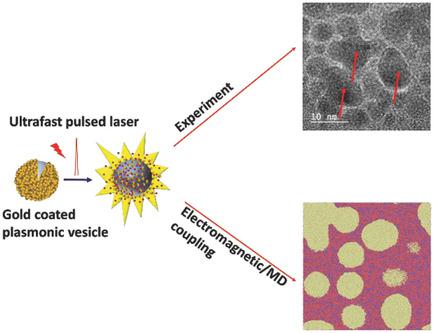当前位置:
X-MOL 学术
›
Adv. Opt. Mater.
›
论文详情
Our official English website, www.x-mol.net, welcomes your feedback! (Note: you will need to create a separate account there.)
Ultrafast Pulsed Laser Induced Nanocrystal Transformation in Colloidal Plasmonic Vesicles
Advanced Optical Materials ( IF 9 ) Pub Date : 2018-09-02 , DOI: 10.1002/adom.201800726 Mohammad Rezaul Karim 1 , Xiuying Li 1 , Peiyuan Kang 1 , Jaona Randrianalisoa 2 , Dineli Ranathunga 3 , Steven Nielsen 3 , Zhenpeng Qin 1, 4, 5 , Dong Qian 1
Advanced Optical Materials ( IF 9 ) Pub Date : 2018-09-02 , DOI: 10.1002/adom.201800726 Mohammad Rezaul Karim 1 , Xiuying Li 1 , Peiyuan Kang 1 , Jaona Randrianalisoa 2 , Dineli Ranathunga 3 , Steven Nielsen 3 , Zhenpeng Qin 1, 4, 5 , Dong Qian 1
Affiliation

|
Plasmonic vesicle consists of multiple gold nanocrystals within a polymer coating or around a phospholipid core. As a multifunctional nanostructure, it has unique advantages of assembling small nanoparticles (<5 nm) for rapid renal clearance, strong plasmonic coupling for ultrasensitive biosensing and imaging, and near‐infrared light absorption for drug release. Thus, understanding the interaction of plasmonic vesicles with light is critically important for a wide range of applications. In this paper, a combined experimental and computational study is presented on the nanocrystal transformation in colloidal plasmonic vesicles induced by the ultrafast picosecond pulsed laser. Experimentally observed merging and transformation of small nanocrystals into larger nanoparticles when treated by laser pulses is first reported. The underlying mechanisms responsible for the experimental observations are investigated with a multiphysics computational approach featuring coupled electromagnetic/molecular dynamics simulation. This study reveals for the first time that combined nanoparticle heating and laser‐enhanced Brownian motion is responsible for the observed nanocrystal merging. Correspondingly, laser fluence, interparticle distance, and presence of water are identified as the most important factors governing the nanocrystal transformation. The guidelines established from this study can be employed to design a host of biomedical and nanomanufacturing applications involving laser interaction with plasmonic nanoparticles.
中文翻译:

胶体等离子体囊泡中超快脉冲激光诱导的纳米晶转变
等离子体囊泡由聚合物涂层内或磷脂核周围的多个金纳米晶体组成。作为一种多功能的纳米结构,它具有独特的优势,可以组装小的纳米颗粒(<5 nm)以实现快速的肾脏清除,牢固的等离子体耦合以用于超灵敏的生物传感和成像,以及近红外光吸收以用于药物释放。因此,了解等离激元囊泡与光的相互作用对于广泛的应用至关重要。本文提出了结合实验和计算研究的超快皮秒脉冲激光诱导的胶体等离子体囊泡中的纳米晶体转变。首次报道了实验观察到的小纳米晶体在通过激光脉冲处理后的融合和转变为更大的纳米颗粒。用多物理场计算方法研究了负责实验观察的潜在机制,该方法具有耦合的电磁/分子动力学模拟。这项研究首次揭示了纳米粒子加热和激光增强的布朗运动相结合是观察到的纳米晶体合并的原因。相应地,激光能量密度,粒子间距离和水的存在被认为是控制纳米晶体转变的最重要因素。这项研究建立的指导方针可用于设计许多生物医学和纳米制造应用,其中涉及与等离子体纳米粒子的激光相互作用。
更新日期:2018-09-02
中文翻译:

胶体等离子体囊泡中超快脉冲激光诱导的纳米晶转变
等离子体囊泡由聚合物涂层内或磷脂核周围的多个金纳米晶体组成。作为一种多功能的纳米结构,它具有独特的优势,可以组装小的纳米颗粒(<5 nm)以实现快速的肾脏清除,牢固的等离子体耦合以用于超灵敏的生物传感和成像,以及近红外光吸收以用于药物释放。因此,了解等离激元囊泡与光的相互作用对于广泛的应用至关重要。本文提出了结合实验和计算研究的超快皮秒脉冲激光诱导的胶体等离子体囊泡中的纳米晶体转变。首次报道了实验观察到的小纳米晶体在通过激光脉冲处理后的融合和转变为更大的纳米颗粒。用多物理场计算方法研究了负责实验观察的潜在机制,该方法具有耦合的电磁/分子动力学模拟。这项研究首次揭示了纳米粒子加热和激光增强的布朗运动相结合是观察到的纳米晶体合并的原因。相应地,激光能量密度,粒子间距离和水的存在被认为是控制纳米晶体转变的最重要因素。这项研究建立的指导方针可用于设计许多生物医学和纳米制造应用,其中涉及与等离子体纳米粒子的激光相互作用。



























 京公网安备 11010802027423号
京公网安备 11010802027423号